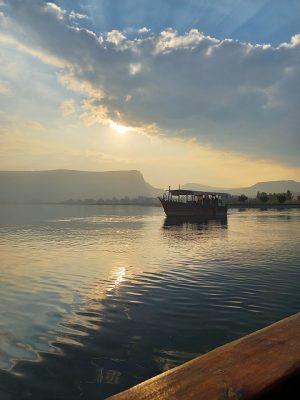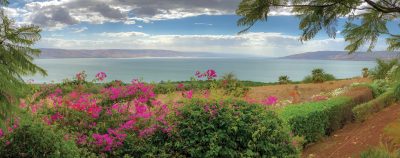
by: Janet Aslin, BFP Staff Writer
 Near the northern end of the Syrian African Rift lies a sparkling gem: Israel’s Sea of Galilee. Known in biblical times as the Sea of Chinnereth (Num. 34:11), this fascinating body of water has nurtured fishermen and farmers, poets and prophets for millennia.
Near the northern end of the Syrian African Rift lies a sparkling gem: Israel’s Sea of Galilee. Known in biblical times as the Sea of Chinnereth (Num. 34:11), this fascinating body of water has nurtured fishermen and farmers, poets and prophets for millennia.
The Sea of Galilee really isn’t a sea at all but the lowest fresh water lake on earth. Known in Israel as the Kinneret, a Hebrew word referencing its harp-like shape, it is not a particularly large lake. It covers an area of 166 square kilometers (64 mi².), and should you decide to walk its circumference, it would take you about 13 hours to complete the 61.3 kilometer (38 mi.) loop.
Water is a precious resource in this land and the Kinneret is Israel’s number-one asset. Therefore, Israelis pay attention to the water levels of the Kinneret, both in times of drought and times of plenteous rainfall. There are specific terms used to describe the water levels of the lake when its shoreline recedes to dangerous points or when the waves come dancing in among the flowering reeds along its banks. You will hear phrases such as the upper red line, the lower red line and the dreaded black line.
When the upper red line is reached, the lake is full and there will be talk about opening the Degania Dam to release water back into the Jordan River. Then there is the lower red line, the point below which damage to the ecological balance and water quality begins to occur. The black line marks the point where permanent damage to the lake happens. It was last reached in 2001. Today, the lake holds a healthy amount of water—slightly more than halfway between the two red lines and 4.33 meters (14.2 ft.) from the black line.
In addition to being a water resource, the Kinneret is home to 30 different species of fish, including several types of tilapia, sardine, “biny” (a carp-like creature) and catfish. Fishing has long played an important role in the economy of the area. Josephus, a famous first-century historian, recorded 230 boats regularly working on the lake. The fishing industry is still alive and well today with about 2,000 tons of fish caught each year. Both professional and amateur fishermen enjoy bounty from the Kinneret.
 If Jerusalem is the spiritual heart of Israel, the Kinneret is a place that inspires and draws creativity from Jewish poets and writers. There has always been a Jewish presence in the Galilee, but those numbers began to grow in the late 1800s and throughout the early 1900s, when many of the returning immigrants came to the area. Among them was Rachel Bluwstein (1890–1931), a young Russian Jewish woman who was to become Israel’s beloved poetess known only by her first name—Rachel.
If Jerusalem is the spiritual heart of Israel, the Kinneret is a place that inspires and draws creativity from Jewish poets and writers. There has always been a Jewish presence in the Galilee, but those numbers began to grow in the late 1800s and throughout the early 1900s, when many of the returning immigrants came to the area. Among them was Rachel Bluwstein (1890–1931), a young Russian Jewish woman who was to become Israel’s beloved poetess known only by her first name—Rachel.
Rachel lived at Kvutzat Kinneret on the shores of the lake, learning agricultural methods and writing poetry inspired by the nearby Kinneret. One of her poems contains these lines: “Perhaps I never woke early and went to the fields to labor in the sweat of my brow. Nor in the long blazing days of harvest on top of the wagon laden with sheaves, made my voice ring with song. Nor bathed myself clean in the calm blue water of my Kinneret. O, my Kinneret, were you there or did I only dream?”
She also wrote eloquent prose, capturing on paper the relationship between the sparkling blue Sea of Galilee and the Jewish people. “It is said: this water has wondrous properties. Whoever has drunk it will return. Is this why the young men abroad long for the quiet shores of the Kinneret, because their ancestors quenched thirst here?”
Another creative voice, born in 1930 at the same community Rachel called home, was Naomi Shemer. Her most famous song, “Jerusalem of Gold,” was penned in 1967, just before the Six Day War began. Shemer was a prolific songwriter and many of her songs reflect her love of her birthplace along the shores of the Sea of Galilee.
Land surrounding the Kinneret has long provided farmers with the ideal conditions—fertile soil, hot climate and access to water—to produce abundant crops. Josephus observed during the first century that this area “supplies men with the principle fruits—grapes and figs continually during the ten months of the year, and the rest of the fruits, as they ripen together during the whole year.”
It should come as no surprise that the land along the shores of the Kinneret drew returning immigrants. But many of them had no practical farming experience and there were obstacles to be overcome. In answer to these challenges, the Kinneret Farm was established in 1908 as an agricultural training facility.
The farm proved itself a catalyst for many of the structures that sustained the new immigrants and would carry forward into the early days of statehood. Some are still in evidence today, such as the Bank HaPoalim (the workers bank) and Tnuva (the world’s largest kosher food manufacturer), which was originally established as a cooperative for milk and dairy products.
Yet the most important and critical innovation in those early days was probably the kibbutz concept of communal living in an agricultural setting. In the years and months before statehood and in the immediate aftermath, the challenges and obstacles were such that only larger groups were able to successfully till the soil that had lain dormant for centuries to bring it back to life.
Nestled between the foothills of the Golan Heights and the mountainous area of the Galilee region, the blue water of the Kinneret has the uncanny ability to draw our attention away from the cares and distractions of the day and shift our focus to the One who created it.
Photo Credit: Click on photo to see photo credit
All logos and trademarks in this site are property of their respective owner. All other materials are property of Bridges for Peace. Copyright © 2025.
Website Site Design by J-Town Internet Services Ltd. - Based in Jerusalem and Serving the World.